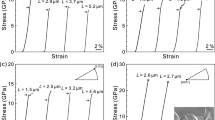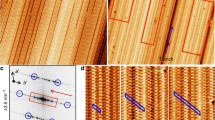Abstract
The exaggerated grain growth, anisotropic crystallite morphology, and thermal expansion are the main reasons for the microcracking of sintered TiB2, wherein grain coarsening and anisotropic crystallite morphology are believed to be controlled by the surface stabilities of TiB2. To deeply understand the grain growth mechanism, the anisotropic stability and bonding features of TiB2 surfaces, including \(\left({11\bar 20} \right)\), two types of (0001), and three types of \(\left({10\bar 10} \right)\), are investigated by first-principles calculations. By employing the two-region modeling method, surface energies are calculated and the \(\left({11\bar 20} \right)\) surface is found to be more stable than (0001) and \(\left({10\bar 10} \right)\) surfaces. Hexagonal plate-like grain morphology is predicted. The different bonding conditions of surface Ti and B atoms contribute to the difference of surface structure relaxation between surfaces with Ti- and B-termination, which lead the B-terminated ones to be more stable. It is also found that the surface energies of TiB2 are much higher than those of ZrB2 with a similar structure, which may be responsible for the easy coarsening of TiB2.






Similar content being viewed by others
References
D.M. van Wie, D.G. Drewry, E.D. King, and C.M. Hudson: The hypersonic environment: Required operation conditions and design challenges. J. Mater. Sci. 39, 5915 (2004).
M.M. Opeka, I.G. Talmy, and J.A. Zaykoski: Oxidation-based materials selection for 2000 °C + hypersonic aerosurfaces: Theoretical considerations and historical experience. J. Mater. Sci. 39, 5887 (2004).
R.G. Munro: Material properties of titanium diboride. J. Res. Natl. Inst. Stand. Technol. 105, 709 (2000).
B. Basu, G.B. Raju, and A.K. Suri: Processing and properties of monolithic TiB2 based materials. Int. Mater. Rev. 51, 6 (2006).
Y.C. Zhou, H.M. Xiang, Z.H. Feng, and Z.P. Li: General trends in electronic structure, stability, chemical bonding and mechanical properties of ultrahigh temperature ceramics TMB2 (TM = transition metal). J. Mater. Sci. Technol. 31, 285 (2015).
T.S.R.Ch. Murthy, B. Basu, and R. Balsubramaniam: Processing and properties of TiB2 with MoSi2 sinter-additive: A first report. J. Am. Ceram. Soc. 89, 131 (2006).
B. Lönnberg: Thermal expansion studies on the group IV–VII transition metal diborides. J. Less-Common Met. 141, 145 (1988).
N.L. Okamoto, M. Kusakari, K. Tanaka, H. Inui, and S. Otani: Anisotropic elastic constants and thermal expansivities in monocrystal CrB2, TiB2, and ZrB2. Acta Mater. 58, 76 (2010).
H.M. Xiang, Z.H. Feng, Z.P. Li, and Y.C. Zhou: Temperature-dependence of structural and mechanical properties of TiB2: A first principle investigation. J. Appl. Phys. 117, 225902 (2015).
A.G. Evans: Microfracture from thermal expansion anisotropy: I. Single phase systems. Acta Metall. 6, 1845 (1978).
B. Liu, V.R. Cooper, Y.W. Zhang, and W.J. Weber: Segregation and trapping of oxygen vacancies near the SrTiO3 Σ3 (112) [110] tilt grain boundary. Acta Mater. 90, 394 (2015).
Y.H. Zhang, B. Liu, and J.Y. Wang: Self-assemble of carbon vacancies in sub-stoichiometric ZrC1−x. Sci. Rep. 5, 18098 (2015).
Y.F. Han, Y.B. Dai, D. Shu, J. Wang, and B.D. Sun: First-principles study of TiB2(0001) surfaces. J. Phys.: Condens. Matter 18, 4197 (2006).
G. Volonakis, L. Tsetseris, and S. Logothetidis: Electronic and structural properties of TiB2: Bulk, surface, and nanoscale effects. Mater. Sci. Eng., B 176, 484 (2011).
S.H. Kang and D.J. Kim: Synthesis of nano-titanium diboride powders by carbothermal reduction. J. Eur. Ceram. Soc. 27, 715 (2007).
L. Bača and N. Stelzer: Adapting of sol–gel process for preparation of TiB2 powder from low-cost precursors. J. Eur. Ceram. Soc. 28, 907 (2008).
B. Shahbahrami, F.G. Fard, and A. Sedghi: The effect of processing parameters in the carbothermal synthesis of titanium diboride powder. Adv. Powder Technol. 23, 234 (2012).
R.E. Newnham: Properties of Materials: Anisotropy, Symmetry, Structure (Oxford Univ. Press, New York, USA, 2005); p. 358.
M.D. Segall, P.J.D. Lindan, M.J. Probert, C.J. Pickard, P.J. Hasnip, S.J. Clark, and M.C. Payne: First-principles simulation: Ideas, illustrations and the CASTEP code. J. Phys. Condens. Matter 14, 2717 (2002).
D. Vanderbilt: Soft self-consistent pseudopotentials in a generalized eigenvalue formalism. Phys. Rev. B: Condens. Matter Mater. Phys. 41, 7892 (1990).
J.P. Perdew, K. Burke, and M. Ernzerhof: Generalized gradient approximation made simple. Phys. Rev. Lett. 77, 3865 (1996).
J.D. Pack and H.J. Monkhorst: “Special points for Brillouin-zone integrations”–A reply. Phys. Rev. B: Condens. Matter Mater. Phys. 16, 1748 (1977).
B.G. Pfrommer, M. Côté, S.G. Louie, and M.L. Cohen: Relaxation of crystals with the quasi-Newton method. J. Comput. Phys. 131, 233 (1997).
P. Vajeeston, P. Ravindran, C. Ravi, and R. Asokamani: Electronic structure, bonding, and ground-state properties of AlB2-type transition-metal diborides. Phys. Rev. B: Condens. Matter Mater. Phys. 63, 045115 (2001).
J.D. Gale and A.L. Rohl: The general utility lattice program (GULP). Mol. Simul. 29, 291 (2003).
W. Sun, J.C. Liu, H.M. Xiang, and Y.C. Zhou: A theoretical investigation on the anisotropic surface stability and oxygen adsorption behavior of ZrB2. J. Am. Ceram. Soc. 99, 4113 (2016).
W.M. Wang, Z.Y. Fu, H. Wang, and R.Z. Yuan: Influence of hot pressing sintering temperature and time on microstructure and mechanical properties of TiB2 ceramics. J. Eur. Ceram. Soc. 22, 1045 (2002).
M.K. Ferber, P.F. Becher, and C.B. Finch: Effect of microstructure on the properties of TiB2 ceramics. J. Am. Ceram. Soc. 66, C–2 (1983).
Z. Fan, Z.X. Guo, and B. Cantor: The kinetics and mechanism of interfacial reaction in sigma fibre-reinforced Ti MMCs. Composites, Part A 28, 131 (1997).
ACKNOWLEDGMENTS
This work was supported by the Natural Sciences Foundation of China under Grant No. U1435206 and No. 51672064, and Beijing Municipal Science & Technology Commission under Grant number Z151100003315012 and D161100002416001.
Author information
Authors and Affiliations
Corresponding author
Rights and permissions
About this article
Cite this article
Sun, W., Xiang, H., Dai, FZ. et al. Anisotropic surface stability of TiB2: A theoretical explanation for the easy grain coarsening. Journal of Materials Research 32, 2755–2763 (2017). https://doi.org/10.1557/jmr.2017.147
Received:
Accepted:
Published:
Issue Date:
DOI: https://doi.org/10.1557/jmr.2017.147




